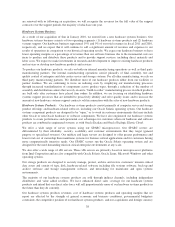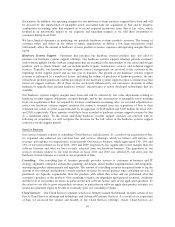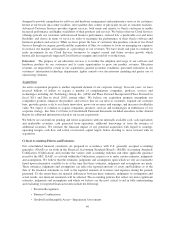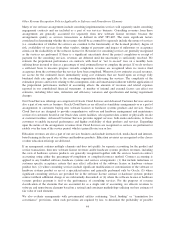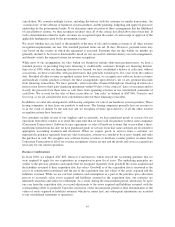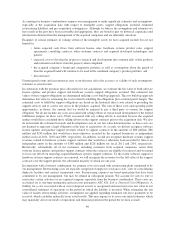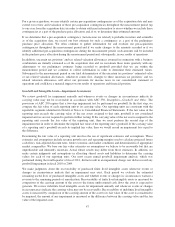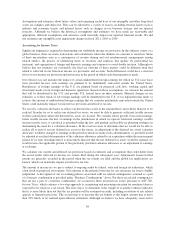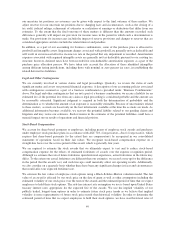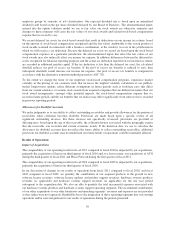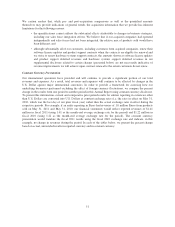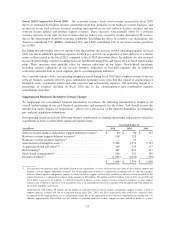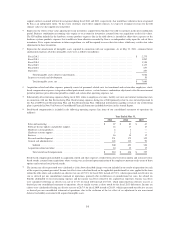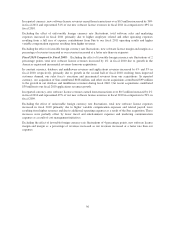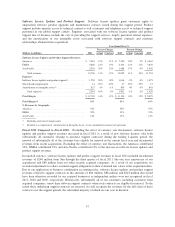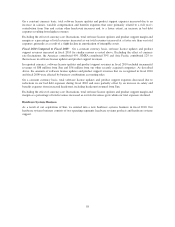Oracle 2011 Annual Report Download - page 50
Download and view the complete annual report
Please find page 50 of the 2011 Oracle annual report below. You can navigate through the pages in the report by either clicking on the pages listed below, or by using the keyword search tool below to find specific information within the annual report.Assumptions and estimates about future values and remaining useful lives of our intangible and other long-lived
assets are complex and subjective. They can be affected by a variety of factors, including external factors such as
industry and economic trends, and internal factors such as changes in our business strategy and our internal
forecasts. Although we believe the historical assumptions and estimates we have made are reasonable and
appropriate, different assumptions and estimates could materially impact our reported financial results. We did
not recognize any intangible asset impairment charges in fiscal 2011, 2010 or 2009.
Accounting for Income Taxes
Significant judgment is required in determining our worldwide income tax provision. In the ordinary course of a
global business, there are many transactions and calculations where the ultimate tax outcome is uncertain. Some
of these uncertainties arise as a consequence of revenue sharing and cost reimbursement arrangements among
related entities, the process of identifying items of revenues and expenses that qualify for preferential tax
treatment, and segregation of foreign and domestic earnings and expenses to avoid double taxation. Although we
believe that our estimates are reasonable, the final tax outcome of these matters could be different from that
which is reflected in our historical income tax provisions and accruals. Such differences could have a material
effect on our income tax provision and net income in the period in which such determination is made.
Our effective tax rate includes the impact of certain undistributed foreign earnings for which no U.S. taxes have
been provided because such earnings are planned to be indefinitely reinvested outside the United States.
Remittances of foreign earnings to the U.S. are planned based on projected cash flow, working capital and
investment needs of our foreign and domestic operations. Based on these assumptions, we estimate the amount
that will be distributed to the U.S. and provide U.S. federal taxes on these amounts. Material changes in our
estimates as to how much of our foreign earnings will be distributed to the U.S. or tax legislation that limits or
restricts the amount of undistributed foreign earnings that we consider indefinitely reinvested outside the United
States could materially impact our income tax provision and effective tax rate.
We record a valuation allowance to reduce our deferred tax assets to the amount that is more likely than not to be
realized. In order for us to realize our deferred tax assets, we must be able to generate sufficient taxable income
in those jurisdictions where the deferred tax assets are located. We consider future growth, forecasted earnings,
future taxable income, the mix of earnings in the jurisdictions in which we operate, historical earnings, taxable
income in prior years, if carryback is permitted under the law, and prudent and feasible tax planning strategies in
determining the need for a valuation allowance. In the event we were to determine that we would not be able to
realize all or part of our net deferred tax assets in the future, an adjustment to the deferred tax assets valuation
allowance would be charged to earnings in the period in which we make such a determination, or goodwill would
be adjusted at our final determination of the valuation allowance related to an acquisition within the measurement
period. If we later determine that it is more likely than not that the net deferred tax assets would be realized, we
would reverse the applicable portion of the previously provided valuation allowance as an adjustment to earnings
at such time.
We calculate our current and deferred tax provision based on estimates and assumptions that could differ from
the actual results reflected in income tax returns filed during the subsequent year. Adjustments based on filed
returns are generally recorded in the period when the tax returns are filed and the global tax implications are
known, which can materially impact our effective tax rate.
The amount of income tax we pay is subject to ongoing audits by federal, state and foreign tax authorities, which
often result in proposed assessments. Our estimate of the potential outcome for any uncertain tax issue is highly
judgmental. A description of our accounting policies associated with tax related contingencies assumed as a part
of a business combination is provided under “Business Combinations” above. For those tax related contingencies
that are not a part of a business combination, we account for these uncertain tax issues pursuant to ASC 740,
Income Taxes, which contains a two-step approach to recognizing and measuring uncertain tax positions taken or
expected to be taken in a tax return. The first step is to determine if the weight of available evidence indicates
that it is more likely than not that the tax position will be sustained on audit, including resolution of any related
appeals or litigation processes. The second step is to measure the tax benefit as the largest amount that is more
than 50% likely to be realized upon ultimate settlement. Although we believe we have adequately reserved for
48


